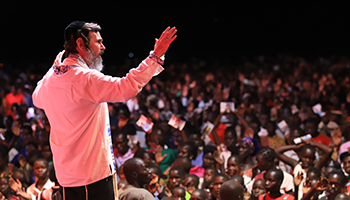The last of the Fall Feasts is called Sukkot-The Feast of Tabernacles. This feast is a joyous and happy time of giving thanks to God for His provision. We read about this feast in Leviticus (23:34-42)
“On the fifteenth of this seventh month is the Feast of Tabernacles for seven days to the LORD… You shall thus celebrate it as a feast to the LORD… It shall be a perpetual statute throughout your generations… You shall live in booths (sukkah) for seven days.”
The last of the Fall Feasts is called Sukkot-The Feast of Tabernacles. This feast is a joyous and happy time of giving thanks to God for His provision. We read about this feast in Leviticus (23:34-42)
“On the fifteenth of this seventh month is the Feast of Tabernacles for seven days to the LORD… You shall thus celebrate it as a feast to the LORD… It shall be a perpetual statute throughout your generations… You shall live in booths (sukkah) for seven days.”
During Sukkot, in many Jewish homes and synagogues, a sukkah will be constructed. A sukkah (meaning tabernacle or booth), is a temporary structure made out of lumber, grass, or any other earthly substance, and is decorated with natural materials including tree branches, leaves, flowers, vegetables and fruit.
Many people will actually eat their meals and sleep in the sukkah for the entire seven days of the feast.
While in the sukkah Jewish people spend time remembering how they had nothing in the wilderness but God. For forty years the LORD supplied their every need. He fed them supernaturally with manna, gave them water out of a rock, and caused their clothes not to wear out.
They had nothing but God.
This is a beautiful foreshadow of how we should live our lives today; totally dependent on Him!
Sukkot also involves the tradition of “the waving of the lulav.” The lulav is a gathering of branches made from four species found in Israel: The Palm branch, Myrtle, Willow and the Etrog (Lev. 23:40).
The lulav is held up and waved before the LORD. By doing this, we are testifying of His beauty and bounty, that He is everywhere, and that all good gifts come from Him! Praise the LORD!
A remarkable tradition that took place during the Feast of Tabernacles in the days of Yeshua is called Hoshana Rabbah. During this ceremony, the priests would march from the pool of Siloam to the altar at the Temple in Jerusalem carrying a pitcher of water. They would then pour the pitcher of water onto the altar. Through this act, the priests were thanking God in advance for the coming winter rains which would produce another bountiful harvest in the spring.



The last of the Fall Feasts is called Sukkot-The Feast of Tabernacles. This feast is a joyous and happy time of giving thanks to God for His provision. We read about this feast in Leviticus (23:34-42)
“On the fifteenth of this seventh month is the Feast of Tabernacles for seven days to the LORD… You shall thus celebrate it as a feast to the LORD… It shall be a perpetual statute throughout your generations… You shall live in booths (sukkah) for seven days.”
During Sukkot, in many Jewish homes and synagogues, a sukkah will be constructed. A sukkah (meaning tabernacle or booth), is a temporary structure made out of lumber, grass, or any other earthly substance, and is decorated with natural materials including tree branches, leaves, flowers, vegetables and fruit.

Many people will actually eat their meals and sleep in the sukkah for the entire seven days of the feast.
While in the sukkah Jewish people spend time remembering how they had nothing in the wilderness but God. For forty years the LORD supplied their every need. He fed them supernaturally with manna, gave them water out of a rock, and caused their clothes not to wear out.
They had nothing but God.
This is a beautiful foreshadow of how we should live our lives today; totally dependent on Him!
Sukkot also involves the tradition of “the waving of the lulav.” The lulav is a gathering of branches made from four species found in Israel: The Palm branch, Myrtle, Willow and the Etrog (Lev. 23:40).

The lulav is held up and waved before the LORD. By doing this, we are testifying of His beauty and bounty, that He is everywhere, and that all good gifts come from Him! Praise the LORD!
A remarkable tradition that took place during the Feast of Tabernacles in the days of Yeshua is called Hoshana Rabbah. During this ceremony, the priests would march from the pool of Siloam

to the altar at the Temple in Jerusalem carrying a pitcher of water. They would then pour the pitcher of water onto the altar. Through this act, the priests were thanking God in advance for the coming winter rains which would produce another bountiful harvest in the spring.
I am so happy that I have found Jesus again!
Rabbi, thank you for boldly proclaiming truth!
I wanted you to know, I am now a Lover of Jesus Christ
You always seemed to know what I needed when I needed it
My 7 year old son Jacob watches your show with me every week.
Receive Rabbi's Seeds of Revelation - a weekly video "Power Minute", Crusade Prayer Alerts, Ministry News and Updates.
Get a Weekly Faith-Boost
| Networks | Monday | Tuesday | Wednesday | Thursday | Friday | Saturday | Sunday |
|---|---|---|---|---|---|---|---|
| KTHV CBS – Little Rock, AR | 10:30AM | ||||||
| KQDK / KQCK / KWHS – Denver, CO | 5:00PM | ||||||
| WRXY – Ft. Myers / Naples, FL | 11:30AM | 11:30AM | 11:30AM | 11:30AM | 11:30AM | ||
| WYKE – Inglis / Yankeetown / Lecanto, FL | 12:30AM | 9:30PM | |||||
| WACX TV – Orlando, FL | 2:00AM | 11:00AM | |||||
| WCLF – Tampa / St. Pete / Sarasota, FL | 10:00PM | ||||||
| WFGC – West Palm / Ft. Pierce, FL | 12:30AM | ||||||
| WLCF – Effingham / Decatur, IL | 8:30PM | ||||||
| KFXB – Cedar Rapids / Dubuque, IA | 8:30PM | ||||||
| WHNO – New Orleans, LA | 8:30PM | ||||||
| WEPH – Columbus / Tupelo, MS | 11:30PM | ||||||
| KFDR – Columbia / Jefferson City, MO | 8:30PM & 11:30PM | ||||||
| KEEN – Las Vegas, NV | 6:30PM | ||||||
| NRQE – Albuquerque, NM | 9:00AM | ||||||
| WLNY – New York City, NY | 9:30AM | ||||||
| WEWS (ABC) – Cleveland, OH | 5:30AM 11:00AM |
||||||
| WQIZ – Cleveland, OH | 1:00AM | 7:30AM | |||||
| COACB (WOCB, WXCB & WGCT) – Columbus, OH | 1:00AM | 7:30AM | |||||
| WTTE – Columbus, OH | 5:00AM | ||||||
| WWHO – Columbus, OH | 10:30AM | ||||||
| WLMB – Toledo, OH | 6:30AM 11:00AM |
6:30AM 11:00AM |
6:30AM 11:00AM |
6:30AM 11:00AM |
6:30AM 11:00AM |
7:30AM | |
| WUPW – Fox 36 Toledo, OH | 6:30AM | 6:30AM | 6:30AM | 6:30AM | 6:30AM | ||
| KWHB – Tulsa, OK | 5:00PM | ||||||
| WFMZ – Allentown, PA | 10:00AM | ||||||
| WFMZ – Wall, PA | 5:00AM 11:30AM |
11:30AM | 10:00AM | ||||
| NOW – Easley, SC | 5:30PM | 6:00AM | 11:30PM | ||||
| WLCN – Charleston / Summerville, SC | 12:30AM | 9:30PM | |||||
| WTNB – Cleveland / Chattanooga, TN | 12:30AM | ||||||
| WZTV FOX – Nashville, TN | 10:30PM | ||||||
| KSCE – El Paso, TX | 10:00AM | 7:00PM | 5:30PM | ||||
| KHLM – Houston, TX | 11:30PM | ||||||
| WTTG (FOX) – Washington D.C. | 10:30AM | ||||||
| WCWF CW – Green Bay, WI | 8:30AM CT | ||||||
| KQDK / KQCK / KWHS – Cheyenne, WY | 5:00PM |
You can complete your gift and support our mission in as little as ten minutes. FreeWill‘s free online tool walks you through the process step-by-step.
If you’ve donated stock previously and are familiar with the process, access Discovering The Jewish Jesus‘s brokerage and DTC information.
Are you a financial advisor working on behalf of your philanthropic client? Use this tool to request a securities transfer on behalf of your clients.
Thanks to our partnership with FreeWill, you can make your QCD gift quickly and hassle-free by beginning your forms online.
Print out blank forms to complete by hand, or transact the gift over the phone with your financial custodian.
This is an necessary category.
This is an non-necessary category.





